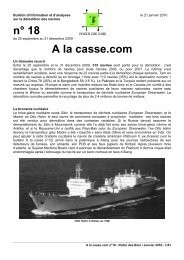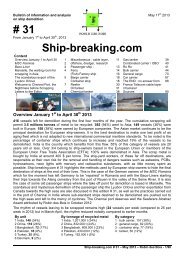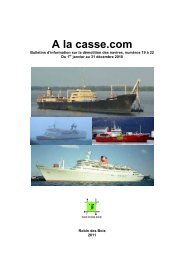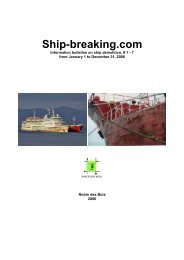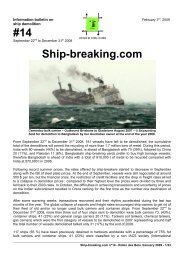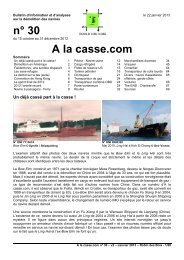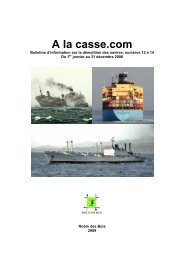Ship-breaking.com. Special issue, global statement ... - Robin des Bois
Ship-breaking.com. Special issue, global statement ... - Robin des Bois
Ship-breaking.com. Special issue, global statement ... - Robin des Bois
You also want an ePaper? Increase the reach of your titles
YUMPU automatically turns print PDFs into web optimized ePapers that Google loves.
Information bulletin on February 3 rd , 2009<br />
ship demolition<br />
#14<br />
September 22 nd to December 31 st 2008<br />
<strong>Ship</strong>-<strong>breaking</strong>.<strong>com</strong><br />
Cementco bulk carrier – Outbound Brisbane to Gladstone August 2007 – © <strong>Ship</strong>spotting<br />
Sold for demolition to Bangla<strong>des</strong>h by her Australian owner at the end of the year 2008.<br />
From September 22 nd to December 31 st 2008, 181 vessels have left to be demolished; the cumulative<br />
total of the demolitions will permit the recycling of more than 1.7 million tons of metal. During this period,<br />
India with 80 vessels (44%) to be demolished, is ahead of Bangla<strong>des</strong>h with 70 (39%), followed by China<br />
20 (11%), and Pakistan 11 (6%). Bangla<strong>des</strong>hi ship-<strong>breaking</strong> yards prefer to buy high tonnage vessels;<br />
therefore Bangla<strong>des</strong>h is ahead of India with a total of 810,000 t of metal to be recycled <strong>com</strong>pared with<br />
India at 570,000 t in 2008.<br />
Following record summer prices, the rates offered by ship-breakers started to decrease in September<br />
along with the fall of steel plate prices. At the end of September, vessels were still negociated at around<br />
500 $ per ton, but the financial crisis, the restriction of credit facilities and the drop in freight rates all led<br />
to a collapse in demolition prices : <strong>com</strong>pared to their highest level the prices were divided by three and<br />
fell back to their 2003 rates. In October, the difficulties in achieving transactions and uncertainty of prices<br />
on the Indian subcontinent resulted in China ranking for the first time as the number one <strong>des</strong>tination of<br />
demolition.<br />
After some wavering weeks, transactions recovered and their rhythm accelerated during the last two<br />
months of the year. The <strong>global</strong> collapse of exports and freight rates encouraged ship-owners to get rid of<br />
their fleet of old and/or no longer used bulk carriers and container ships. From September 22 nd to<br />
December 31 st 2008, more than three out of four ships sent to demolition were bulk carriers 73, (43%),<br />
container ships, 41 (23%) and general cargo carriers 20 (11%). Tankers (oil tankers, chemical tankers,<br />
gas carriers) which were the first category of vessels to be demolished in 2007 representing around half<br />
the total number of vessels demolished tallied only 31 (17%) by the end of 2008.<br />
117 ships (65 %) have been previously detained in harbours worldwide with a percentage of 75% for<br />
bulk carriers and container ships. 41 (23%) were classified by a non IACS society (International<br />
_____________________________________________________________________________________<br />
<strong>Ship</strong>-<strong>breaking</strong>.<strong>com</strong> n°14 - <strong>Robin</strong> <strong>des</strong> <strong>Bois</strong> /January 2009 - 1/23



